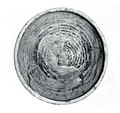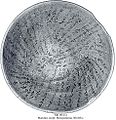
Incantation bowl

Incantation bowls are a form of protective magic found in what is now Iraq and Iran. Produced in the Middle East during late antiquity from the sixth to eighth centuries, particularly in Upper Mesopotamia and Syria,[1] the bowls were usually inscribed in a spiral, beginning from the rim and moving toward the center. Most are inscribed in Jewish Babylonian Aramaic.

The bowls were buried face down and were meant to capture demons. They were commonly placed under the threshold, courtyards, in the corner of the homes of the recently deceased and in cemeteries.[2]

The majority of Mesopotamia's population were either Christian, Manichaean, Mandaean, Jewish, or adherents of the ancient Babylonian religion, all of whom spoke Aramaic dialects. Zoroastrians who spoke Persian also lived here. Mandaeans and Jews each used their own Aramaic variety, although very closely related. A subcategory of incantation bowls are those used in Jewish and Christian magical practice (see Jewish magical papyri for context). The majority of recovered incantation bowls were written in Jewish Aramaic. These are followed in frequency by the Mandaic language and then Syriac. A handful of bowls have been discovered that were written in Arabic or Persian. An estimated 10% of incantation bowls were not written in any real language but pseudo-script. They are thought to be forgeries by illiterate “scribes” and sold to illiterate clients. The bowls are thought to have been regularly commissioned across religious lines.[3]

Archaeological finds
To date only around 2000 incantation bowls have been registered as archaeological finds, but since they are widely dug up in the Middle East, there may be tens of thousands in the hands of private collectors and traders. Aramaic incantation bowls from Sasanian Mesopotamia are an important source for studying the everyday beliefs of Jews, Christians, Mandaeans, Manichaeans, Zoroastrians, and pagans on the eve of the early Muslim conquests.[4]

In Judaism

A subcategory of incantation bowls are those used in Jewish and Christian magical practice.[5][6] Aramaic incantation bowls are an important source of knowledge about Jewish magical practices, particularly the nearly eighty surviving Jewish incantation bowls from Babylon during the rule by the Sasanian Empire (226-636), primarily from the Jewish diaspora settlement in Nippur. These bowls were used in magic to protect against evil influences such as the evil eye, Lilith, and Bagdana.[7][8] These bowls could be used by any member of the community, and almost every house excavated in the Jewish settlement in Nippur had such bowls buried in them.[9]

The inscriptions often include scriptural quotes and quotes from rabbinic texts. The text on incantation bowls is the only written material documenting Jewish language and religion recovered from the period around the writing of the Babylonian Talmud. Scholars say that the use of rabbinic texts demonstrates that they were considered to have supernatural power comparable to that of biblical quotes. The bowls often refer to themselves as "amulets" and the Talmud discusses the use of amulets and magic to drive away demons.[10]

In Christianity
This section needs expansion. You can help by adding to it. (May 2020) |
In Christianity, during the same period and in the same region where traditional incantation bowls were prevalent, Christian incantation bowls emerged. These artifacts, often inscribed in Syriac, a dialect of the Aramaic language, demonstrate a syncretism of Christian and local magical beliefs. The inscriptions on these bowls typically include prayers, psalms, or invocations for protection against evil forces. Scholars interpret them as a unique manifestation of the blending of Christian and folk religious practices in the ancient Middle East. Further research may delve into specific examples, deciphering the content of the inscriptions and exploring the cultural significance of these Christian incantation bowls within their historical context.

In Mandaeism
There are also many incantation bowls written in Mandaic. Mandaic incantation bowls have been found in various archaeological sites in southern Mesopotamia, including bowls from Nippur that date to the early Islamic era.[11]

Many are kept in museums and private collections around the world, including the British Museum and the Moussaieff Collection.[12][13]

-
Bowl with incantation for Buktuya and household, c. 200-600 AD - Royal Ontario Museum
-
Bowl with incantation for Kuktan Pruk during her pregnancy, Southern Mesopotamia, c. 200-600 AD - Royal Ontario Museum
-
Bowl with incantation to protect Anush Busai and his family against bad luck, southern Mesopotamia, c. 200-600 AD - Royal Ontario Museum
-
Incantation bowl with Mandaic inscription
-
Incantation bowl with inscriptions in Mandaic, Mesopotamia
-
c. 5th-7th century, incantation bowl, 19x7.5 cm, 44 lines in cursive Mandaic script in 3 blocks at different angles radiating from the centre
See also
References
- ^ Severn Internet Services - www.severninternet.co.uk. "Incantation bowls". Bmagic.org.uk. Retrieved 2013-09-06.
- ^ "Babylonian Demon Bowls". Michigan Library. Lib.umich.edu. Retrieved 2013-09-06.
- ^ "What should be done with the magic bowls of Jewish Babylonia? – Samuel Thrope | Aeon Essays". Aeon. Retrieved 2018-06-06.
- ^ "Syria Incantation Bowls". Archived from the original on 2016-06-01. Retrieved 2015-11-03.
- ^ C. H. Gordon: “Aramaic Incantation Bowls” in Orientalia, Rome, 1941, Vol. X, p. 120ff (Text 3).
- ^ Orientalia 65 3-4 Pontificio Istituto biblico, Pontificio Istituto biblico. Facoltà di studi dell'antico oriente - 1996 "may have been Jewish, but Aramaic incantation bowls also commonly circulated in pagan communities". ... Lilith was, of course, the frequent subject of concern in incantation bowls and amulets, since her presence was ."
- ^ The International Standard Bible Encyclopedia p217 Geoffrey W. Bromiley 1986 2007 "D. Aramaic Incantation Bowls. One important source of knowledge about Jewish magical practices is the nearly eighty extant incantation bowls made by Jews in Babylonia during the Sassanian period (ad 226-636). ... Though the exact use of the bowls is disputed, their function is clearly apotrapaic in that they are meant to ward off the evil effects of a number of malevolent supernatural beings and influences, e.g., the evil eye, Lilith, and Bagdana."
- ^ A Dictionary of biblical tradition in English literature p454 David L. Jeffrey - 1992 "Aramaic incantation bowls of the 6th cent, show her with disheveled hair and tell how"
- ^ Descenders to the chariot: the people behind the Hekhalot literature Page 277 James R. Davila - 2001 "... that they be used by anyone and everyone. The whole community could become the equals of the sages. Perhaps this is why nearly every house excavated in the Jewish settlement in Nippur had one or more incantation bowl buried in it."
- ^ "Naming Demons: The Aramaic Incantation Bowls and Gittin - TheGemara.com". TheGemara.com. 2016-02-14. Archived from the original on 2018-05-22. Retrieved 2018-06-06.
- ^ Hunter, Erica C. D., ‘Incantation Bowls: A Mesopotamian Phenomenon?’, Orientalia, 65 (1996), 220–233.
- ^ Morgenstern, Matthew (2012). Magic Bowls in the Moussaieff Collection: A Preliminary Survey. In M. and E. Lubetski (eds.), New Inscriptions and Seals Relating to the Biblical World, 157–170. Society of Biblical Literature Publications.
- ^ Morgenstern, Matthew (2005). "Linguistic notes on magic bowls in the Moussaieff Collection". Bulletin of the School of Oriental and African Studies. 68 (3): 349–367. doi:10.1017/S0041977X05000200. ISSN 0041-977X. JSTOR 20181947.
Further reading
- Bhayro, Siam, James Nathan Ford, Dan Levene, and Ortal-Paz Saar, Aramaic Magic Bowls in the Vorderasiatisches Museum in Berlin. Descriptive List and Edition of Selected Texts [Magical and Religious Literature of Late Antiquity 7], 2018.
- Ford, James Nathan and Matthew Morgenstern, Aramaic Incantation Bowls in Museum Collections. Volume One: The Frau Professor Hilprecht Collection of Babylonian Antiquities, Jena [Magical and Religious Literature of Late Antiquity 8], 2019.
- Gioia, Ted, "Healing songs", Format: Book, Electronic Resource 2006
- Gordon, Cyrus H. “Aramaic Incantation Bowls.” Orientalia, vol. 10, 1941, pp. 116–141. JSTOR, JSTOR, www.jstor.org/stable/43582631.
- Harari, Yuval, "Jewish Magic before the Rise of Kabbala", 2017.
- Juusola, Hannu, "Linguistic peculiarities in the Aramaic magic bowl texts", Format: Book, Electronic Resource, 1999.
- Levene, Dan, "A corpus of magic bowls : Incantation texts in Jewish Aramaic from late antiquity", format: Book, Electronic Resource, 2003.
- McCullough, William Stewart, "Jewish and Mandaean incantation bowls in the Royal Ontario Museum", 1967.
- Montgomery, James A., "Aramaic Incantation Texts from Nippur", 1913.
- Müller-Kessler, Christa, "Die Zauberschalentexte in der Hilprecht-Sammlung, Jena und weitere Nippur-Texte anderer Sammlungen", 2005.
- Naveh, Joseph and Shaked, Shaul, "Amulets and magic bowls : Aramaic incantations of late antiquity", 1985.
- Naveh, Joseph and Shaked, Shaul, “Magic Spells and Formulae : Aramaic Incantations of Late Antiquity", 1993.
- Kedar Dorit, Who wrote the Incantation Bowls? PhD Diss. (Freie Universität Berlin) 2018.
External links
See what we do next...
OR
By submitting your email or phone number, you're giving mschf permission to send you email and/or recurring marketing texts. Data rates may apply. Text stop to cancel, help for help.
Success: You're subscribed now !






